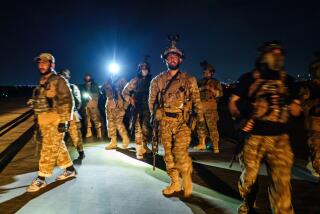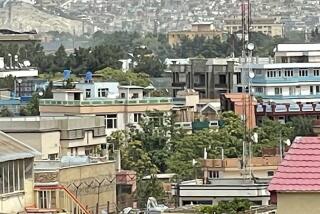Pakistan Taliban regrouping outside Waziristan
- Share via
Reporting from Islamabad, Pakistan — Since the Pakistani army launched a long-awaited offensive last month to destroy the Taliban in South Waziristan, many militants have fled to nearby districts and begun to establish new strongholds, a strategy that suggests they will regroup and remain a potent threat to the country’s weak, U.S.-backed government.
Pakistani Taliban militants have escaped primarily to Kurram and Orakzai, districts outside the battle zone but still within Pakistan’s largely ungoverned tribal areas along the Afghan border, villagers there say. The military lacks a significant presence in much of these areas, making them an ideal environment for the Islamic militants to regroup.
Newly arrived militants have terrorized Pashtun residents and replenished their coffers through kidnappings and robberies, villagers said during interviews in the Kurram and Orakzai districts. With AK-47s and rocket launchers slung over their shoulders, the militants have begun patrols through the new territory and have set up checkpoints.
“They come to our houses and terrorize us,” said Fareed Ullah, a student in Weedara, a hamlet of mud-walled huts in central Kurram. “They are kidnapping our elders and stealing our cars. We have no way of rising up against them, and there’s no government here to help us. . . . Kurram is in trouble because of them.”
Pakistani military commanders say that after five weeks of fighting, they are in the final stages of their offensive aimed at crushing Islamic insurgents in South Waziristan, a rugged expanse of mountains and plateaus that for years has served as the primary base of operations for the Pakistani Taliban and as a sanctuary for Al Qaeda fighters.
When the offensive began Oct. 17, Pakistani military leaders said they faced a fighting force of as many as 10,000 battle-hardened militants. Thus far, however, the army has put the number of militants killed at 500.
None of the Pakistani Taliban’s top leaders have been reported captured or killed. And accounts from villagers in nearby districts suggest that many militants simply fled South Waziristan.
The 30,000 troops involved in the South Waziristan offensive have reported taking control of almost all the villages and roads once held there by Taliban militants. At the start of the offensive, military commanders and government leaders said they wanted to wrap up the operation before winter set in. They now say they are on track to meet that goal ahead of schedule.
In some cases, Pakistani troops met fierce resistance from Taliban militants and Al Qaeda-allied Uzbek fighters as they advanced on villages such as Kotkai and Sararogha, a key nerve center for the Pakistani Taliban. In many places, however, troops found that Taliban and Al Qaeda militants had already left.
Army leaders say dislodging Taliban and Al Qaeda fighters from their strongholds may be enough to neutralize them.
“Once dislodged, they will be disorganized,” said Pakistani army spokesman Maj. Gen. Athar Abbas. “Their actions will not have that kind of coordination which was displayed when they were attacking our cities and towns.”
However, militants have succeeded in engineering a devastating string of terrorist attacks on Pakistani cities that has coincided with the offensive. Especially hard hit has been Peshawar, a northwestern city with a population of almost 3 million on the fringe of Pakistan’s volatile tribal areas. More than 245 people, most of them civilians, have been killed in 10 bomb attacks in the largely Pashtun city since early October. Authorities believe militants fleeing South Waziristan to their new havens far closer to Peshawar are probably behind many of the attacks.
Taliban and Al Qaeda militants were able to easily flee South Waziristan, experts say, because government and military leaders announced their intent to carry out a major offensive in the region weeks before troops moved in. That gave militants ample time to make their escape.
“The strategy has been bad,” said Imtiaz Gul, a security analyst based in Islamabad, the Pakistani capital. “You don’t carry out operations after making such announcements. This area gives them huge space for mobility. So when crunch time comes, they can disperse to safer places, regroup, reorganize and hit the state somewhere else.”
The Obama administration has said it is pleased with gains made by the Pakistani military against the Taliban in South Waziristan. But U.S. officials have nonetheless questioned Pakistan’s resolve to find and eliminate Al Qaeda leaders and commanders believed to have been hiding there.
Villagers in Kurram and Orakzai, as well as two Orakzai-based Taliban commanders, say Al Qaeda-aligned Arab, Chechen and Uzbek fighters from South Waziristan are now in their villages.
“From their faces we can see they are foreigners,” said Jaleel Rahman, a Pashtun of the village of Marghan in central Kurram. “Sometimes they speak in Arabic, sometimes in English. Their leaders stay at the houses of influential people in our area. And we can’t do anything about it.”
Almost always, militants fleeing South Waziristan arrive at night in large groups piled into Toyota Land Cruisers and pickup trucks, villagers say. The newcomers have established hide-outs in the foothills and mountains skirting the villages, and have been seen digging trenches in mountainsides. Without any troops to confront them, they freely roam through villages, demanding money, food and guns.
“They are in the hundreds here,” said Sher Muhammad, a tribesman in the village of Tandar in central Kurram. “They tell us to do what they do. And whatever they like, they get by force.”
Both the Orakzai and Kurram districts had large sections controlled by Pakistani Taliban militants before fighters from South Waziristan began appearing. However, the Taliban presence in those districts wasn’t considered as large as the militant group’s forces in South Waziristan, long considered the hub for terrorism in Pakistan.
Maulana Zainul Abideen, a Pakistani Taliban commander in the Orakzai region, said during an interview in his village of Dabori that locals have set aside empty houses for fellow militants and their families arriving from South Waziristan.
“They accompany us wherever we go on patrol,” Abideen said. “They contacted our elders, and our elders allowed them to come here.”
Another Taliban commander in the Orakzai region, Mufti Khursheed, said the fleeing militants had to agree they would not “carry out any activity without us, would have to patrol with us and would join us wherever we need them. They will not take any step without our permission.”
Pakistani fighter jets and helicopter gunships have stepped up airstrikes on suspected Taliban hide-outs in Orakzai and Kurram, military leaders say. But analysts say that may not be enough. Once South Waziristan is secured, some say, a ground offensive either in Orakzai or Kurram may be needed to keep the Taliban from establishing strongholds there on a par with what it had in South Waziristan. The military says it plans to keep a sizable troop presence in South Waziristan to hold the ground gained, just as it did in its previous Swat Valley offensive.
“The militants have the capacity to regroup and come back,” said retired Gen. Talat Masood, an Islamabad-based defense analyst. “They should not be allowed to consolidate. . . . South Waziristan has been a tactical success of sorts, but by no means is it a victory.”
Special correspondents Rasheed Khan in the Kurram district and Hassan Mahmood in the Orakzai district contributed to this report.
More to Read
Sign up for Essential California
The most important California stories and recommendations in your inbox every morning.
You may occasionally receive promotional content from the Los Angeles Times.













